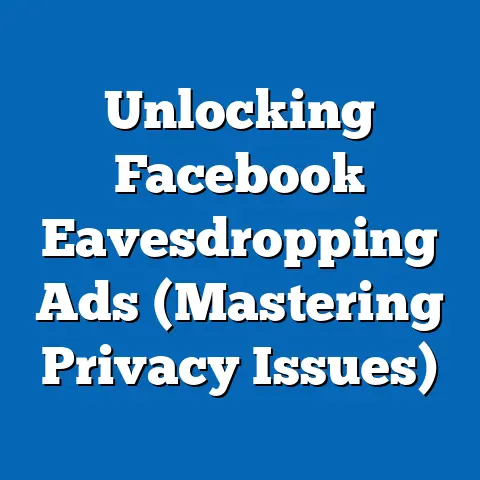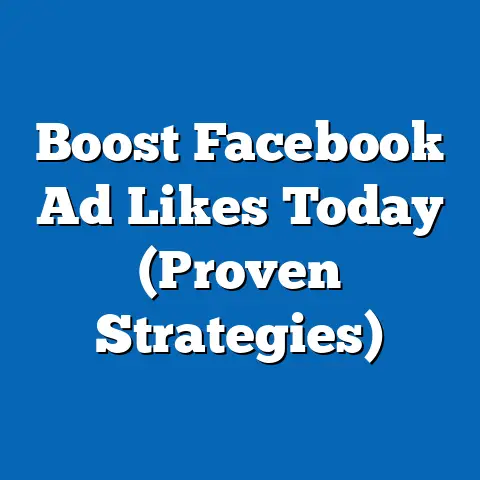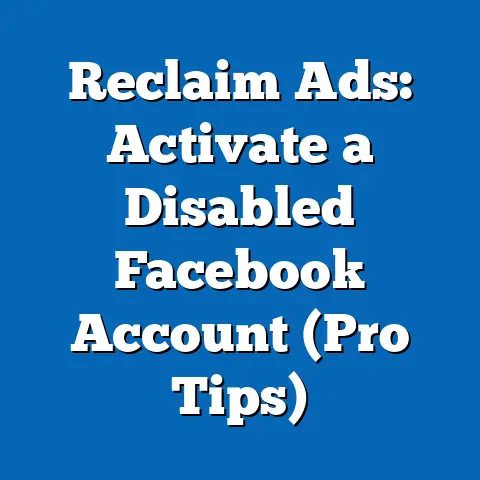Why Won’t My Facebook Ad Publish? (Expert Troubleshooting Tips)
This isn’t just a list of generic tips; it’s a comprehensive roadmap to help you understand why your Facebook ads might be struggling to see the light of day and, more importantly, how to fix it. I’ll break down the process, share some hard-won insights, and arm you with the knowledge to get your ads up and running, so you can finally start seeing the results you deserve.
Understanding Facebook Ad Publishing
Before we jump into the nitty-gritty troubleshooting, let’s establish a solid foundation by understanding the Facebook ad publishing process. It’s more than just hitting the “Publish” button; it’s a journey through Facebook’s internal systems designed to ensure ads align with their policies and community standards.
The Facebook Ad Approval Process: A Two-Step Dance
Think of the Facebook ad approval process as a carefully choreographed dance with two key partners: automated review and manual review.
- Automated Review: This is the first line of defense, a sophisticated algorithm that scans your ad’s text, images, landing page, and targeting parameters. It’s lightning-fast but can sometimes be a bit overzealous, flagging ads for seemingly minor infractions. I’ve seen ads get rejected for using the word “you” too many times (seriously!), so it’s crucial to understand the types of triggers that can set off the algorithm.
- Manual Review: If the automated system flags your ad, or if it’s a type of ad that requires extra scrutiny (like those related to sensitive topics like finance or healthcare), it’s passed on to a human reviewer. This person takes a closer look to ensure everything is above board. While a human reviewer might catch subtle nuances that an algorithm misses, they’re also working under time constraints and may make mistakes. I once had an ad rejected because the reviewer misinterpreted the image – a perfectly innocent picture of a group of friends laughing was deemed “offensive.” It took some back-and-forth with Facebook support to clear it up.
The Significance of Facebook’s Advertising Policies and Community Standards
Facebook’s advertising policies and community standards are the bedrock of its ad ecosystem. They’re designed to protect users from misleading, offensive, or harmful content. Think of them as the rulebook for playing the Facebook ad game.
- Advertising Policies: These are the specific rules that govern what you can and cannot advertise on Facebook. They cover a wide range of topics, from prohibited content (like illegal products or services) to restrictions on sensitive subjects (like politics, religion, and social issues).
- Community Standards: These are broader guidelines that outline what’s acceptable behavior on Facebook. They apply not just to ads but to all content on the platform. Violating these standards can lead to ad disapproval or even account suspension.
I cannot stress enough the importance of thoroughly reading and understanding these policies. Facebook is constantly updating them, so it’s essential to stay informed. I make it a habit to review the policies at least once a quarter to ensure my ads are compliant.
Common Reasons for Ad Disapproval: The Usual Suspects
Even with the best intentions, ads can get disapproved or stuck in the review process. Here are some of the most common culprits:
- Misleading or Deceptive Content: Ads that make false claims, exaggerate results, or use clickbait tactics are a big no-no. I’ve learned to be extra careful with wording, avoiding phrases like “guaranteed results” or “instant success.”
- Inappropriate Content: This includes anything that’s offensive, discriminatory, or violent. It’s not just about avoiding obvious hate speech; even seemingly harmless content can be flagged if it’s deemed to be insensitive or exploitative.
- Personal Attributes: Facebook prohibits ads that directly target users based on their personal attributes, such as race, ethnicity, religion, sexual orientation, or health status. You can’t say things like “Are you a single mother?” or “Looking for people with diabetes.”
- Grammar and Punctuation: Believe it or not, poor grammar and punctuation can also lead to ad disapproval. Facebook wants to maintain a professional image, so ads with sloppy writing are often rejected.
- Landing Page Issues: Your ad’s landing page must be relevant to the ad’s content and provide a positive user experience. If your landing page is slow to load, contains broken links, or is filled with pop-up ads, your ad is likely to be disapproved.
Takeaway: Understanding the Facebook ad approval process and its underlying policies is the first step towards getting your ads published successfully. Take the time to familiarize yourself with the rules of the game, and you’ll be less likely to run into problems down the road.
Common Reasons for Ads Not Publishing
Now that we’ve covered the basics, let’s delve deeper into the specific reasons why your Facebook ads might be failing to publish. I’ve categorized these reasons into four main buckets: policy violations, account status issues, technical errors, and audience targeting problems.
Policy Violations: The Most Frequent Offender
Policy violations are by far the most common reason why Facebook ads get disapproved. Facebook is extremely strict about enforcing its advertising policies, and even a seemingly minor infraction can lead to rejection.
- Prohibited Content: This is the most obvious category of policy violations. It includes anything that’s illegal, harmful, or offensive. Think drugs, weapons, hate speech, and scams.
- Restricted Content: This category is a bit more nuanced. It includes content that’s not strictly prohibited but is subject to certain restrictions. Examples include alcohol, gambling, dating services, and financial products. These types of ads often require special authorization from Facebook.
- Misleading or Deceptive Claims: As mentioned earlier, Facebook prohibits ads that make false claims or exaggerate results. This includes unsubstantiated health claims, unrealistic promises of wealth, and deceptive business practices.
- Sensational Content: Facebook also frowns upon ads that use sensational or shocking content to grab attention. This includes clickbait headlines, graphic images, and emotionally manipulative tactics.
I once had an ad rejected because it featured a before-and-after photo of a weight loss product. Even though the product was legitimate and the results were real, Facebook considered the ad to be “sensational” and potentially misleading.
Ad Account Status: A Matter of Health
The health of your Facebook ad account is another critical factor in determining whether your ads will publish successfully. If your account is in bad standing, your ads are likely to be disapproved or even prevented from running altogether.
- Account Suspension: This is the most severe penalty. If your account is suspended, you won’t be able to run any ads on Facebook. Suspensions are typically triggered by repeated policy violations or fraudulent activity.
- Payment Issues: If your payment method is invalid or your account has outstanding charges, Facebook will stop running your ads until the issue is resolved.
- Low Ad Relevance Score: While a low ad relevance score won’t directly prevent your ads from publishing, it can significantly impact their performance. Ads with low relevance scores are often shown to fewer people and cost more to run.
I’ve learned to be proactive about maintaining my ad account health. I regularly check my account status in Ads Manager, monitor my ad relevance scores, and ensure my payment information is up to date.
Technical Errors: The Glitches in the Machine
Sometimes, the reason your ads aren’t publishing has nothing to do with policy violations or account status. It’s simply a technical glitch in the Facebook system.
- Browser Issues: Outdated or incompatible browsers can sometimes interfere with the ad publishing process.
- Cache and Cookies: Corrupted cache and cookies can also cause problems.
- Facebook Bugs: Let’s face it, Facebook isn’t perfect. Sometimes, there are bugs in the system that can prevent ads from publishing.
I’ve found that clearing my browser’s cache and cookies, updating to the latest version of my browser, and trying a different browser can often resolve these types of technical issues.
Audience Targeting Problems: The Goldilocks Zone
Your audience targeting settings can also impact whether your ads get published. Facebook wants to ensure that ads are shown to relevant audiences, so overly narrow or broad targeting can be problematic.
- Overly Narrow Targeting: If your audience is too small, Facebook may not be able to deliver your ads effectively. This can lead to ad disapproval or limited reach.
- Targeting Sensitive Categories: As mentioned earlier, Facebook prohibits targeting users based on their personal attributes, such as race, ethnicity, religion, or sexual orientation.
- Incorrect Location Targeting: Make sure your location targeting is accurate. If you’re targeting a specific city or region, double-check that you’ve entered the correct information.
Takeaway: Identifying the specific reason why your ads aren’t publishing is crucial for resolving the issue. By understanding the common pitfalls and troubleshooting steps, you can increase your chances of getting your ads approved and running successfully.
Troubleshooting Steps
Okay, so your ad isn’t publishing. Don’t panic! Let’s walk through the troubleshooting steps for each of the common issues we just discussed. I’ll share my personal tips and tricks for getting your ads back on track.
Policy Violations: The Compliance Checklist
If you suspect that your ad is being rejected due to a policy violation, here’s what you need to do:
- Review Facebook’s Advertising Policies: This is the most important step. Take the time to thoroughly read and understand Facebook’s advertising policies. Pay close attention to the sections that are relevant to your industry and ad content.
- Identify the Specific Violation: Once you’ve reviewed the policies, try to pinpoint the specific violation that’s causing your ad to be rejected. Facebook usually provides some information about the reason for disapproval, but it can sometimes be vague.
- Edit Your Ad: Once you’ve identified the violation, edit your ad to remove the offending content. This might involve changing the text, images, or targeting settings.
- Resubmit Your Ad: After you’ve made the necessary changes, resubmit your ad for review. Be patient; it can take some time for Facebook to review your ad again.
My Pro Tip: Use the Facebook Ad Library to see examples of ads that are running successfully in your industry. This can give you a better understanding of what’s acceptable and what’s not.
Account Status: The Health Check
If you suspect that your ad account status is the problem, here’s how to check and resolve any issues:
- Check Your Account Quality: Go to your Facebook Business Manager and click on “Account Quality.” This will give you an overview of your account’s health and any potential issues.
- Resolve Payment Issues: If you have any outstanding charges or payment issues, resolve them immediately. Update your payment information and make sure your payment method is valid.
- Appeal Suspensions: If your account has been suspended, you can appeal the decision. Provide as much information as possible to support your case.
My Pro Tip: Keep a close eye on your ad account metrics, such as ad relevance score and feedback score. These metrics can give you early warnings about potential problems.
Technical Errors: The Digital Detox
If you suspect that technical errors are to blame, try these troubleshooting steps:
- Clear Your Browser’s Cache and Cookies: This is often the first and easiest solution. Clearing your cache and cookies can resolve many browser-related issues.
- Update Your Browser: Make sure you’re using the latest version of your browser. Outdated browsers can sometimes cause compatibility issues.
- Try a Different Browser: If you’re still having problems, try using a different browser. This can help you determine if the issue is specific to your browser.
- Check Your Internet Connection: Make sure you have a stable internet connection. A weak or unreliable connection can sometimes interfere with the ad publishing process.
My Pro Tip: If you’re still having trouble, try contacting Facebook support. They may be able to help you diagnose and resolve the issue.
Audience Targeting: The Sweet Spot
If you suspect that your audience targeting settings are the problem, try these adjustments:
- Broaden Your Audience: If your audience is too small, try broadening your targeting parameters. This might involve expanding your age range, geographic location, or interests.
- Exclude Sensitive Categories: Avoid targeting users based on their personal attributes, such as race, ethnicity, religion, or sexual orientation.
- Use Lookalike Audiences: Lookalike audiences can be a great way to reach new people who are similar to your existing customers.
My Pro Tip: Use Facebook’s Audience Insights tool to get a better understanding of your target audience. This can help you refine your targeting settings and improve your ad performance.
Takeaway: Troubleshooting Facebook ad publishing issues requires a systematic approach. By following these step-by-step guides, you can identify and resolve the most common problems and get your ads running smoothly.
Advanced Tips for Persistent Issues
Sometimes, despite your best efforts, you might still encounter persistent issues with your Facebook ads not publishing. In these cases, it’s time to delve into more advanced strategies and tactics.
Understanding Facebook’s Algorithm: The Invisible Hand
Facebook’s algorithm plays a significant role in determining which ads get approved and which ones get rejected. While the exact workings of the algorithm are a closely guarded secret, there are some general principles that can help you understand how it works.
- Relevance: Facebook prioritizes ads that are relevant to the user. The more relevant your ad is, the more likely it is to be approved and shown to the right people.
- Quality: Facebook also considers the quality of your ad. High-quality ads are more likely to be approved and perform well.
- User Experience: Facebook wants to ensure that users have a positive experience on the platform. Ads that are disruptive, annoying, or misleading are likely to be rejected.
I’ve learned that the best way to please the algorithm is to focus on creating high-quality, relevant ads that provide value to the user. This means crafting compelling ad copy, using engaging visuals, and targeting the right audience.
The Role of Ad Fatigue: The Creativity Factor
Ad fatigue occurs when users become tired of seeing the same ad over and over again. When this happens, your ad’s performance can decline, and it may even be rejected by Facebook.
- Frequency: The frequency of your ad is a key factor in ad fatigue. The more often users see your ad, the more likely they are to become fatigued.
- Relevance: The relevance of your ad also plays a role. If your ad is not relevant to the user, they’re more likely to become fatigued.
- Creativity: The creativity of your ad is another important factor. Ads that are fresh and engaging are less likely to cause ad fatigue.
I’ve found that the best way to combat ad fatigue is to regularly refresh your ad creative. This means creating new ads with different images, text, and targeting settings.
Leveraging Facebook’s Support Resources: The Help Desk
When all else fails, don’t hesitate to leverage Facebook’s support resources. Facebook offers a variety of support options, including:
- Help Center: The Help Center is a comprehensive resource that contains answers to many common questions.
- Community Forums: The community forums are a great place to connect with other advertisers and get help from experts.
- Live Chat: Facebook also offers live chat support for some advertisers. This can be a great way to get immediate assistance with your ad publishing issues.
I’ve personally used Facebook’s live chat support on several occasions, and I’ve always found them to be helpful and responsive.
Takeaway: Persistent issues with Facebook ads not publishing can be frustrating, but they’re not insurmountable. By understanding Facebook’s algorithm, combating ad fatigue, and leveraging Facebook’s support resources, you can overcome these challenges and get your ads running successfully.
Case Studies and Real-Life Examples
To illustrate the troubleshooting process, let’s dive into some real-life case studies where marketers encountered publishing issues and how they resolved them.
Case Study 1: The Misinterpreted Image
- The Problem: A local bakery was running an ad featuring a photo of their freshly baked goods. The ad was rejected because Facebook’s algorithm flagged the image as potentially promoting unhealthy eating habits.
- The Solution: The bakery owner contacted Facebook support and explained that the ad was simply showcasing their products and was not intended to promote unhealthy eating habits. After reviewing the ad, Facebook approved it.
- The Lesson: Sometimes, Facebook’s algorithm can make mistakes. If you believe your ad has been wrongly rejected, don’t hesitate to contact Facebook support and appeal the decision.
Case Study 2: The Overly Narrow Audience
- The Problem: A small business was running an ad targeting a very specific demographic in a small geographic area. The ad was not publishing because the audience was too small.
- The Solution: The business owner broadened their targeting parameters by expanding their geographic area and adding more interests. This increased the size of their audience and allowed the ad to publish successfully.
- The Lesson: Make sure your audience is large enough to allow Facebook to deliver your ads effectively. If your audience is too small, try broadening your targeting parameters.
Case Study 3: The Policy Violation Slip-Up
- The Problem: A marketing agency was running an ad for a client that made unsubstantiated claims about the product’s effectiveness. The ad was rejected because it violated Facebook’s policy against misleading claims.
- The Solution: The agency edited the ad to remove the unsubstantiated claims and replaced them with factual information about the product. The revised ad was approved by Facebook.
- The Lesson: Always be truthful and accurate in your ad copy. Avoid making unsubstantiated claims or exaggerating the benefits of your product or service.
Takeaway: These case studies demonstrate that even experienced marketers can encounter publishing issues with their Facebook ads. The key is to remain calm, troubleshoot the problem systematically, and learn from your mistakes.
Conclusion
Navigating the world of Facebook advertising can be challenging, especially when your ads refuse to publish. But with a clear understanding of Facebook’s ad policies, a systematic approach to troubleshooting, and a willingness to learn from your mistakes, you can overcome these challenges and create successful ad campaigns.
Remember these key takeaways:
- Understand Facebook’s ad policies: This is the foundation of successful Facebook advertising.
- Troubleshoot systematically: Identify the specific reason why your ad isn’t publishing and follow the appropriate troubleshooting steps.
- Stay informed: Facebook’s ad policies and features are constantly evolving, so it’s important to stay up to date.
- Don’t be afraid to ask for help: Facebook offers a variety of support resources, so don’t hesitate to leverage them when you need assistance.
By taking a proactive approach to your ad publishing process and remaining persistent in the face of challenges, you can unlock the full potential of Facebook advertising and achieve your business goals. Now go forth and conquer the Facebook ad world!






